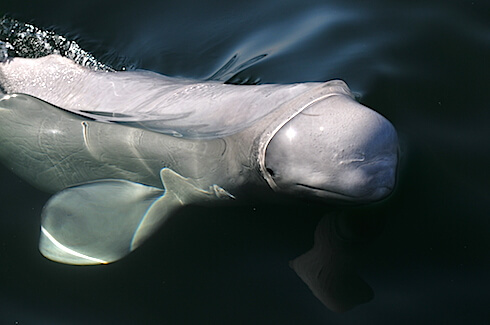Is it possible to identify an all-white beluga? Certainly, especially when it shows a major spinal deformity like Pascolio! This female was recognized twice this past week near Batture aux Alouettes in Tadoussacby our collaborator Renaud Pintiaux (in French). Otherwise, belugas can be distinguished thanks to permanent markings such as spots, scars and notches in their dorsal crest. Such details most often go unnoticed by amateurs or inexperienced observers, but researchers involved in whale photo-ID work have an eye for finding and comparing these subtle details. Indeed, after the field work (during which scientists photograph each flank of the individuals encountered) begins the laborious lab analyses where photos are closely examined and compared with those of other individuals before finally being matched according to a series of rigorous criteria. And, contrary to what many would have you believe, to date, no computer program has been able to provide a result as accurate as human visual recognition of photos!
Thanks to his sharp eyes, a GREMM research assistant strongly suspects that he has recognized Bp955, a.k.a. “Ti-croche” among the fin whales seen in early May in the Marine Park, thanks to the photographs of an experienced naturalist and seasoned photographer. This is because Bp955 has a dorsal fin that is strongly hooked toward the rear; few fin whales show a dorsal of this shape. Captains and naturalists in the area also recognize this unique trait. However, the identification of “Ti-croche” is not 100% confirmed, as its chevron was not visible in the photo. Fin whales have not been seen in recent days, but between five and seven minke whales have been frequenting the mouth of the Saguenay. In Franquelin, two fin whales were seen on May 17.
Humpback whales often reveal their identity through the colouration and markings of their tail. No dice for a Gaspésie-based collaborator, who saw a humpback tail emerge from the water surface on May 14 near the marina in Rivière-au-Renard, but was unable to make out any characteristics unique to the animal.
Also, in Sept-Îles, the capelin began to roll. This expression refers to the time of year when these small fish venture onto certain beaches of the St. Lawrence to lay their eggs, which remain buried in the substrate until they hatch. In the Côte-Nord region, spawning normally takes place from mid-April to early July. For locals, it’s an extraordinary fishing experience where the catch is even harvested with buckets or shovels. For whales, especially coastal minke whales, it’s an all-out feast. However, no minke whales were spotted this week in the area by our local collaborators.
Lastly, in the Longue-Pointe-de-Minganarea, a marine mammal measuring 2 to 3 m and weighing up to 500 kg was purportedly seen. No, it wasn’t a whale, but rather a polar bear (article in French)! The Quebec Department of Forests, Wildlife and Parks has launched a field investigation to confirm the report.





